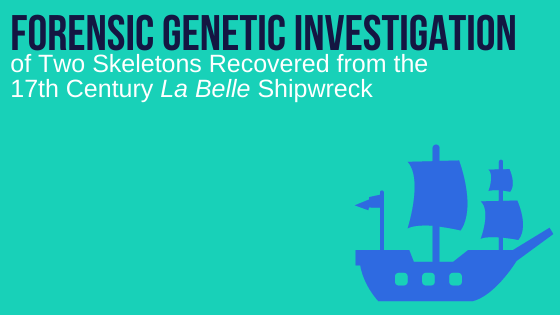Today’s blog is written by Angie Ambers, Ph.D., Assistant Director at Henry C. Lee Institute of Forensic Science. Read the full version in the November 2020 issue of The ISHI Report.
Born in 1643, the French explorer Robert Cavalier (Sieur de La Salle) is best known for leading an expedition from the Great Lakes region of the United States and Canada along the Mississippi River, discovering the mouth of the river as it flowed into the Gulf of Mexico. In 1682, he claimed the Mississippi river basin for France and named it ‘Louisiana’ in honor of King Louis XIV. After returning to France in 1683, La Salle was commissioned by the king to sail back to the New World (North American continent), establish a French colony at the mouth of the Mississippi River, and to do reconnaissance on a possible later French invasion of Spain’s silver mines in Nueva Vizcaya (modern-day northern Mexico). In the summer of 1684, La Salle departed France with a large expedition of four hundred sailors and colonists aboard a fleet of four ships (Le Joly, L’Aimable, Le Saint-Francois, and La Belle)
In September 1684, the Le Saint-Francois was seized by privateers and only three ships made it to the French Caribbean port of Petit-Goave (present-day Haiti), a planned stop along the journey to the New World. After a few months of respite at Petit-Goave, La Salle’s remaining expedition sailed towards the Gulf of Mexico. In 1685, the fleet arrived at the western Louisiana coast and proceeded to navigate along the Texas coastline using rough geographical maps previously constructed by La Salle and his mapmaker. The expedition mistakenly landed at Matagorda Bay (near the city of Victoria, Texas), approximately four hundred miles southwest of their intended destination (the mouth of the Mississippi River). At this point in the journey, Le Joly (a military escort ship) returned to France. The remaining two ships, L’Aimable and La Belle, entered Matagorda Bay because the area offered protection from rough seas, pirates, and Spanish soldiers. L’Aimable (a much larger ship than La Belle) ran aground navigating the pass. La Belle successfully entered and anchored in the bay; La Salle and some of his men then explored the surrounding terrain, searching on foot for the mouth of the Mississippi River.
Provisions from La Belle and Le Joly (removed from the latter before it set sail back to France), as well as some cargo salvaged from the wreck of L’Aimable, were used to forge a temporary encampment along the coastline at the entrance to Matagorda Bay. Throughout the year 1685, La Salle continued searching for the mouth of the Mississippi River and began building a French settlement thirty miles (~48 kilometers) inland, a colony known as Fort St. Louis. In early 1686, La Belle was caught in a storm and sank to the bottom of the bay, along with the many provisions for the French colony. Within a year, the colonists were struggling due to shortage of supplies and food. In January 1687, La Salle left on foot with sixteen men to seek help. During the journey, La Salle was murdered by his own men, and the local Karankawa Indians massacred the remaining colonists at Fort St. Louis (except for some of the children, who were taken to be raised with the tribe). La Salle’s expedition chronicler, Henri Joutel, made it to Canada and sailed back to France; his journal details the events of the ill-fated expedition.
Spain learned of the French attempt to establish a colony in the part of the New World they controlled and authorized eleven expeditions to find La Salle’s settlement. In 1689, Spanish explorer Alonso de Leon arrived at the Texas coastline and discovered the remains of La Salle’s French colony; another expedition found the partially submerged remains of La Belle and sketched the approximate location of the shipwreck. For three centuries, the ship remained at the bottom of the Matagorda Bay. In the late 1970s, using the seventeenth-century Spanish map, Henri Joutel’s expedition journal, and a magnetometer (a remote-detection instrument similar to a highly sensitive metal detector), the Texas Historical Commission (THC) attempted to locate the shipwreck. Early magnetometer searches involved dragging a magnetometer sensor behind a search vessel and recording readings relayed from the sensor to a receiver in the cabin of the boat. The premise of using a magnetometer in the search relies on the fact that most shipwrecks contain ferrous metal (e.g., in the form of bolts or other fittings that hold wooden timbers together). Intensive surveys of the waters in the Matagorda Bay were conducted, but ended without success.
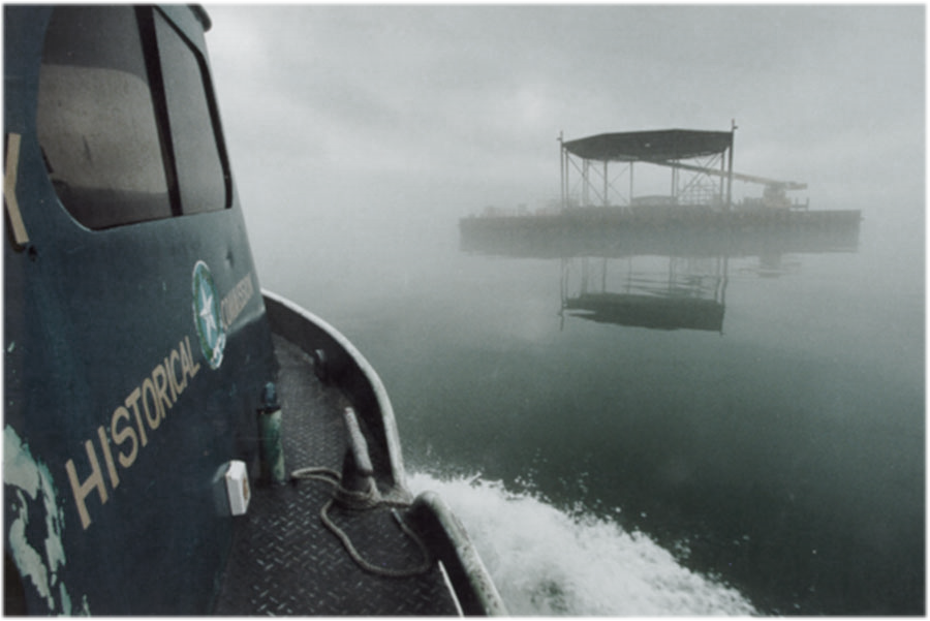 | 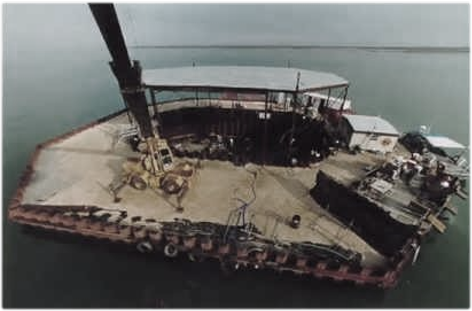 |
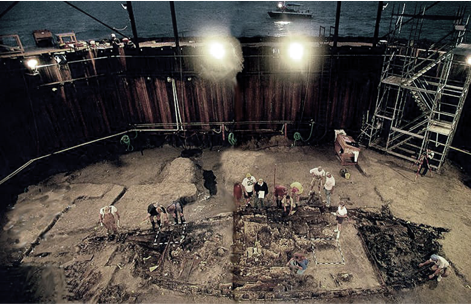 | 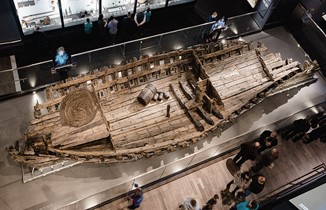 |
Figure 1: Excavation of La Belle by the Texas Historical Commission (THC) archaeological team involved construction of a cofferdam in the Matagorda Bay on the Gulf Coast of Texas. A cofferdam is a temporary enclosure built within a body of water that allows the water in the enclosed area to be pumped out. This created a dry excavation site for the La Belle shipwreck. The hull of La Belle was restored and is on display at the Bullock Texas State History Museum in Austin, Texas, along with numerous artifacts recovered from the shipwreck site (bottom right). Photo courtesy of the Texas Historical Commission.
Over time, technological advances in marine archaeology improved the investigators’ chances of locating the historical shipwreck. The THC resumed its search for La Belle using an improved magnetometer coupled to a Global Positioning System (GPS), which used satellites to accurately track magnetic readings and their respective positions in the water. In 1995, after twenty years of searching, THC divers investigating the source of a magnetic signal near the Matagorda Peninsula discovered a bronze cannon bearing the insignia of The Count of Vermandois (admiral of France from 1669-1683 and illegitimate son of King Louis XIV), confirming that La Belle had been found.
With support from the Texas legislature, $1.75 million was appropriated for excavation of the La Belle shipwreck. Numerous Texas philanthropists and private foundations subsequently donated additional funding to augment the government’s allocation. In 1996, a double-walled metal cofferdam was constructed around the shipwreck and water was pumped out of the site, allowing for a dry excavation of La Belle and its contents. This was the first de-watered cofferdam excavation conducted in the Western Hemisphere, and more than 1.8 million artifacts were recovered. The remaining portions of the hull of La Belle has since been restored and is on display at the Bullock Texas State History Museum in Austin, Texas, along with numerous artifacts recovered from the shipwreck site.
Among the artifacts discovered by the archaeology team were human skeletal remains. “Individual One” was a partial skeleton (right fibula, one metatarsal, two foot phalanges, two hand phalanges) recovered from alongside cargo in the rear portion of the ship. A complete skeleton of an adult male (“Individual Two”) was found on top of coiled anchor rope in the bow of the ship. Early attempts (late 1990s) at DNA recovery were unsuccessful. Numerous advances in DNA technology have occurred since the discovery of La Belle. In late 2015, DNA testing commenced on the skeletal remains. To maximize the amount of genetic information that could be recovered from the remains, a broad range of DNA markers in the human genome were targeted for analysis, including autosomal short tandem repeats (STRs), Y-chromosome STRs (Y-STRs), X-chromosome STRs (X-STRs), ancestry-informative single nucleotide polymorphisms (aiSNPs), phenotypic-informative SNPs (piSNPs), identity-informative SNPs (iiSNPs), and mitochondrial DNA (mtDNA). One female analyst conducted all testing on the skeletal remains of both “Individual One” and “Individual Two,” including surface cleaning and decontamination, bone pulverization, DNA extraction, DNA quantification, PCR amplification, Y-STR genotyping (CE), massively parallel sequencing (MPS) (ForenSeq™ panel), and whole mitochondrial genome sequencing.
Read the full article in the ishi report!
Start reading!

